Andosols
Table of contents
-
Introduction
-
Parent material and environment
-
Regional Distribution
-
Definition
-
Genesis
a. Genesis under cool-humid and acid conditions
b. Genesis under warm-humid, less acid soil conditions and
lower organic matter production
c. Characteristic features to consider
-
Characteristics of Andosols
a. Morphological characteristics
b. Physical characteristics
c. Chemical characteristics
-
Management and Use of Andosols
1. Introduction
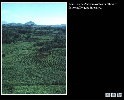 |
| Fig.1 Andosol landscape. Here: mollic Andosols,
Rwanda |
| (
Source: ISRIC, NL.) |
-
The name Andosols refers to the Japanese words an = black and
do = soils, i.e. black soils of volcanic landscapes.
-
Andosols belong to the Reference Soil Groups set #3 of the
WRB reference system. This set includes mineral soils whose formation is
conditioned by the particular properties of their parent material (World Soil
Resources Report 94, 2001).
-
Andosols developed in volcanic material and are strongly
influenced by pyroclastic material (= mixture of volcanic ashes, stones and
gases).
-
They are internationally known as:
-
Andisols = Soil Taxonomy, USDA
-
Andosols = France
-
Black Dust Soils = Indonesia
-
Soapy Hills = West-Indies
-
others: volcanic ash soils
2. Parent material and environment
Parent material:
-
mainly volcanic ash, but also tuff, pumice, cinders and other
volcanic ejecta (for pictures on stones go to:
 http://www2.volstate.edu/svinson/geo100/minerals.html). http://www2.volstate.edu/svinson/geo100/minerals.html).
-
The mineralogy differs in various regions but volcanic
glasses, feldspars, Fe/Mg-minerals, Al-Humus-complexes and quartz are widely
distributed.
-
Mixture of
 amorphous non-crystalline minerals
in the clay fraction and clay minerals amorphous non-crystalline minerals
in the clay fraction and clay minerals
Environment:
-
Undulating to mountainous, humid, arctic to tropical regions
with a wide range of vegetation types.
3. Regional Distribution
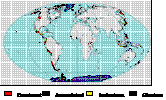 |
| Fig.2 Andosols worldwide |
| (
Source: FAO, 2001.) |
-
The total Andosol area worldwide is estimated at about 110
Mio. ha (~ 1 %). More than half of this is situated in the tropics.
-
Major concentrations of Andosols are found around the Pacific
Rim, Rift Valley Africa, Japan, New Zealand, pacific islands, Europe (Island,
Italy).
-
Many Andosols occur in densely populated areas.
4. Definition
-
Must have an andic or vitric horizon within 25 cm of the soil
surface.
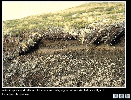 |
| Fig.3 Vitric Andosols, Chile |
| (
Source: ISRIC, NL.) |
Definition vitric:
1. 10 % or more  volcanic glasses in the fine earth
fraction (can be checked with x10 hand lens) (coarse texture) volcanic glasses in the fine earth
fraction (can be checked with x10 hand lens) (coarse texture)
2a.
( BD)
= > 0.9
Mg/ m3 or BD)
= > 0.9
Mg/ m3 or
2b. Amorphous Al and Fe content > 0.4 % (acid oxalat
extractable) or
2c. P-retention > 25 % and
3. Thickness of the horizon > 30 cm
Definition andic:
 |
| Fig.4 Andic horizon |
| (
Source: http://sol.ensam.inra.fr) |
-
> 5 % organic carbon (dark colored, fine
textured)
-
< 10 % volcanic glasses, many
 allophanes and/or
Al-Humus-complexes allophanes and/or
Al-Humus-complexes
-
10 % or more clay
-
BD at field capacity (no prior drying) of < 0.9 Mg/
m3
-
Amorphous Al and Fe > 2 % (acid oxalat
extractable)
-
P-retention > 70 %
-
thickness > 30 cm
5. Genesis
-
Andosols are characterized by the presence of either an andic
or a vitric horizon. An andic horizon is rich in allophanes or Al-humus
complexes whereas a vitric horizon contains an abundance of volcanic glass (see
World Resources Report 94, 2001).
a. Genesis under cool-humid and acid
conditions
-
Formation of acid Andosols occurs predominantly on acid
substrate (rhyolite, older tuff, ignimbrite) under cool-humid and acid soil
conditions (pH 3.5 to 5).
-
Release of Si and Al3+ during
rapid weathering of volcanic parent material.
-
Al (and Fe) and organic acids and organic matter form stable
and immobile Al-humus complexes. Si competes with humus/organic acids for Al.
The free Si is either washed out from the soil or forms opaline Si (if not
sufficient Al is present).
-
The more humid: higher production of organic matter and
stronger leaching of Si.
-
[note: under acid conditions plant material and organic
matter form a thick layer on the soil surface. During decomposition organic
acids are released.]
-
As Al protects organic matter from decomposition (is toxic
for microorganisms) a thick dark organic horizon may form.
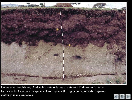 |
| Fig.5 Formation of a melanic horizon: intense dark
color and high content of OM |
| (
Source: FAO, 2001.) |
b. Genesis under warm-humid, less acid soil
conditions (pH 5.5 to 8) and lower organic matter
production
-
Fast and high release of Si, Al and Fe from weathering of
volcanic parent material.
-
Al forms together with Si and Fe amorphous, non-crystalline
minerals as allophane, imogolite and ferrihydrite.
c. Characteristic features to
consider
-
Youngest and least weathered part of the pedon is the surface
layer
-
The formation of Andosols is further complicated if there is
repeated deposition of fresh ash forming different horizons.
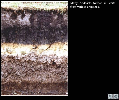 |
| Fig.6 Formation in various layers |
| (
Source: FAO, 2001.) |
 |
| Fig.7 Formation in various layers: haplic Andosol,
Japan |
| (
Source: ISRIC, NL.) |
-
Is often confounded with horizons that developed
pedogenically.
 |
| Fig.8 Ash layers from various volcanic eruptions.
Here, a non weathered 200 year old white ash layer overlies a red-brown 8000
year old ash layer (Pacific Northwest of USA). Was first considered wrongly as
Podzol (albic-spodic sequence). |
| (
Source: http://soils.usda.gov/.../orders/ andisols.html ) |
-
Thin ash layers may just rejuvenate the surface soil material
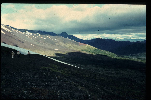 |
| Fig.9 Vitric Andosol, Chile |
| (
Source: ISRIC, NL.) |
but thicker layers bury the soil. A new profile
will then develop in the fresh ash layer while soil formation in the buried
A-horizon takes a different course in response to the suddenly decreased
organic matter supply and the different composition of the soil moisture.
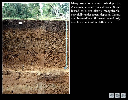 |
| Fig.10 Many Andosols contain buried
soil |
| (
Source: FAO, 2001.) |
-
Strong variability (locally and temporarily) of parent
material depending on wind direction and volcanic ejecta during eruption.
 |
| Fig.11 Ignimbrite zonation, Mazama, Oregon (6,845
yr ago) |
| (
Source: www.geology.sdsu.edu/.../ pinnacles_page.html) |
-
In Fig.11 the pale (
 felsic) lower part is of rhyolitic
origin and the darker upper part ( felsic) lower part is of rhyolitic
origin and the darker upper part ( mafic) stems from andesitic
volcanism. The zonation is inverse to the zonation of the material in the magma
chamber before the volcanic eruption. mafic) stems from andesitic
volcanism. The zonation is inverse to the zonation of the material in the magma
chamber before the volcanic eruption.
6. Characteristics of Andosols
6a. Morphological
characteristics
-
Profile development mostly is AC oder ABC with a dark Ah
(often 20 to 50 cm thick) on top of a brown B or C horizon. The A-horizon is
thicker and darker as those of other soils in the region.
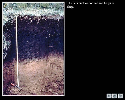 |
| Fig.12 Dark A-horizon |
| (
Source: FAO, 2001.) |
Under grass often mollic Andosols develop
 |
| Fig.13 Mollic Andosol, Chile |
| (
Source: ISRIC, NL.) |
whereas under forest vegetation umbric Andosols may
form.
 |
| Fig.14 Umbric Andosol, Japan |
| (
Source: ISRIC, NL.) |
-
In some Andosols the surface soil material is smeary (feels
greasy) due to solid-liquid changes under pressure (
 thixotropy). This makes Andosols
susceptible to landslides, usually after prolonged heavy rains, as the high
water holding capacity of andic horizons increases their weight. thixotropy). This makes Andosols
susceptible to landslides, usually after prolonged heavy rains, as the high
water holding capacity of andic horizons increases their weight.
6b. Physical
characteristics
-
The bulk density (BD) of Andosols is low (< 0.9 Mg
m-3). It is recommended to calculate contents on a
volume basis, using BD.
-
The quantity of available water is generally greater than in
other mineral soils.
-
Most Andosols have a good internal drainage, high porosity,
high water infiltration, good aggregate stability.
Note: excessive air-drying of
Andosol material will irreversibly deteriorate water holding properties, ion
exchange capacities, soil volume, and ultimately the cohesion of soil particles
through irreversible shrinkage of the colloidal surfaces. Therefore it is
necessary to work on field moist samples.
6c. Chemical
characteristics
-
Based on weathering intensity, composition of volcanic parent
material
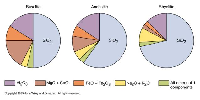 |
| Fig.15 Soil components of Basaltic, Andesitic and
Rhyolitic soils |
|
and climatic conditions, the chemical properties of
Andosols differ greatly.
 |
| Fig.16 Chemical variability of Andosol
soils |
| (
Source: Van Wambeke, 2003.) |
-
Andosols are variable-charge soils (non-crystalline amorphous
structure of minerals), i.e. the cation exchange capacity
(
 cation exchange capacity)
depends on the pH of
the soil solution. cation exchange capacity)
depends on the pH of
the soil solution.
 |
| Fig.17 Andosol No. 905 contains only allophane and
imogolite: develop negative charges (CEC) and positive charges (AEC), depending
on the pH of the solution. Andosol No. H-1-1 contains Al-humus complexes: has
only negative surface charges (CEC) which increases with increasing
pH. |
| (
Source: Van Wambeke, 1992.) |
-
Depending on the composition of Andosol soils, i.e. their
quantity of amorphous allophanes and Al-humus complexes phosphorous
(P)-retention is very high (up to 70 %; higher than for Ferralsols). Strongest
P-fixation occurs through allophanes and imogolites (great reactive surface).
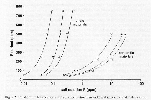 |
| Fig.18 Andic material fixes all of the added P (5,
25, 50, 75 ppm). The P-retention correlates with the density of active Al of
the colloidal fraction and the high specific surface of the amorphous
materials. |
| (
Source: Buol et al. (2003).) |
7. Management and Use of Andosols
Andosols have a high potential for agricultural production. By
and large, Andosols are fertile soils, particularly Andosols in intermediate or
basic volcanic ash and not exposed to excessive leaching. The strong P
fixation, however, is a problem.
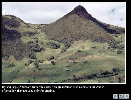 |
| Fig.19 Umbric Andosol, Ecuador |
| (
Source: FAO, 2001.) |
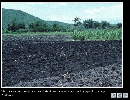 |
| Fig.20 Dark surface colour is typical for many
Andosols |
| (
Source: FAO, 2001.) |
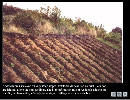 |
| Fig.21 Potato fields, Ecuador |
| (
Source: FAO, 2001.) |
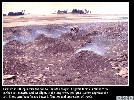 |
| Fig.22 Farmers burn the soil, Ethiopia |
| (
Source: FAO, 2001.) |
|

 previous | next
previous | next

 previous | next
previous | next